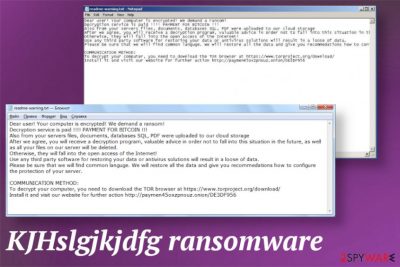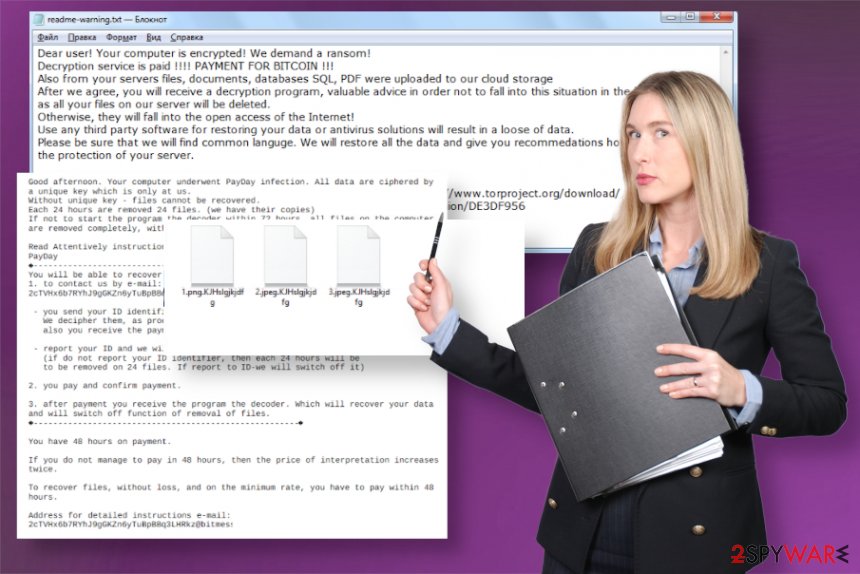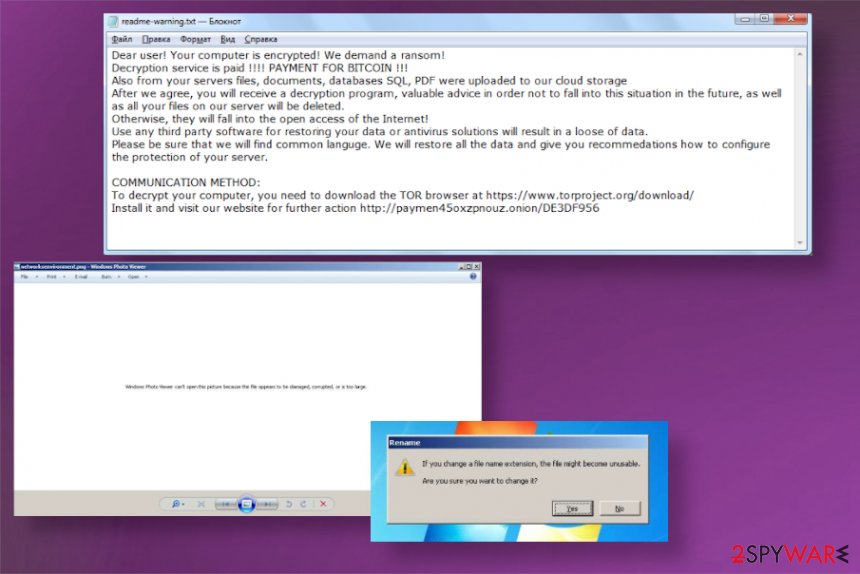KJHslgjkjdfg ransomware (Virus Removal Instructions) - Decryption Methods Included
KJHslgjkjdfg virus Removal Guide
What is KJHslgjkjdfg ransomware?
KJHslgjkjdfg ransomware – cryptovirus that creates issues with the machine once data gets permanently locked and encoded

KJHslgjkjdfg ransomware virus is powerful in encryption and coding because developers managed to release this version not so long after previous threats. It is possible that this family of ransomware is currently on the rise, and we may expect more variants in the future. At the moment, there are not many facts about the particular intruder because it has been spreading for a few days only.
It is known that once the machine is infected by the ransomware common types of files get locked and appended using the particular extension that comes after the original name and file-type marker. From there images, documents, and even archives get locked, unreachable. Unfortunately, the best options could be KJHslgjkjdfg ransomware decryption, but the official tool is not released or developed, and contacting developers is never recommended. The sooner you remove this malware, the better, and you can then recover at least some of the files possibly.
| Name | KJHslgjkjdfg ransomware |
|---|---|
| Type | Cryptovirus |
| Family | Paymen45 ransomware is the first virus that released a randomized extension with other features that belong to this variant too |
| Extension | .KJHslgjkjdfg appears at the end of every file affected during the ransomware attack and marks encrypted files from other not affected data |
| Ransom note | readme-warning.txt is opened and posted in various folders, so the victim can read instructions and pay up as soon as possible |
| Distribution | It can be delivered through insecure RDP configurations, via exploited vulnerabilities or during the email campaigns when spam notifications include malicious files as attachments and releases malicious macro viruses on the machine |
| Danger | The threat includes blackmailing techniques and involves demands for money. When the victim pays data may be left unencrypted, so people suffer data and money losses |
| Elimination | To remove KJHslgjkjdfg ransomware, you should get a proper anti-malware tool and run that on the system, so all associated files get removed and virus terminated |
| System recovery | There are many parts of the computer that ransomware can affect, so run the system tool like FortectIntego to find affected files and repair some of the corrupted functions automatically |
You may get freaked out when all the files that you commonly access on the system get the extension and become locked. KJHslgjkjdfg ransomware encourages people to pay the ransom for the file recovery and claims to offer the only solution. Experts[3] nor any researchers or malware experts recommend contacting these people. Cybercriminals focus on getting money from victims and rely on these scaring tactics, so people are concerned about their data when the ransom note is posted on the desktop and added in other folders.
The readme-warning.txt file is the message from virus creators and contains a few details about preferences that malware developers have and the initial encouragement to contact them and pay up. There is no particular amount listed, but KJHslgjkjdfg ransomware prefers Bitcoin cryptocurrency. Based on similar variants the amount can possibly go up to hundreds or thousands of dollars in Bitcoin.
KJHslgjkjdfg ransomware creators state:
Dear user! Your computer is encrypted! We demand a ransom!
Decryption service is paid !!!! PAYMENT FOR BITCOIN !!!
Also from your servers files, documents, databases SQL, PDF were uploaded to our cloud storage
After we agree, you will receive a decryption program, valuable advice in order not to fall into this situation in the future, as well as all your files on our server will be deleted.
Otherwise, they will fall into the open access of the Internet!
Use any third party software for restoring your data or antivirus solutions will result in a loose of data.
Please be sure that we will find common languge . We will restore all the data and give you recommedationshow to configure the protection of your server.
COMMUNICATION METHOD:
To decrypt your computer, you need to download the TOR browser at https://www.torproject.org/download/
Install it and visit our website for further action http://paymen45oxzpnouz.onion/DE3DF956
KJHslgjkjdfg ransomware is a particularly malicious threat that affects Windows devices and also leaves various other files all over the system to affect the programs and functions running on the computer. There are many changes this threat can make, so the initial virus detection is evaded, and victims have a difficult time cleaning the system from the traces of cryptovirus.
However, the best option for KJHslgjkjdfg ransomware removal process is anti-malware tools. Engines based on antivirus detection are designed to check the system for malicious files and programs, indicate threats, and delete them from the system. Unfortunately, the detection results often are affected by system damage and alterations made in the system, so you may need to rely on Safe Mode with Networking or similar techniques before you run the AV tool. 
It may become impossible to remove KJHslgjkjdfg ransomware overtime because malware adds other programs and applications, malware to control particular functions and parts of the machine. This is why anti-malware tools are the best because detection allows finding all the associated threats. Decryption can be extremely expensive and still give no results for you and your files.
KJHslgjkjdfg ransomware may load other malware when you contact the developers and infect the system even more instead of releasing the decryption tool or key. In many cases, ransomware creators do not have such tools developed and only tricks people into paying the ransom by claiming to allegedly recover files for them later on. Security tools are not capable of repairing files after such instances, so you need to rely on data backups or other software.
Other possible solutions may include decryption tools developed by researchers and malware experts, but KJHslgjkjdfg ransomware is not decryptable yet. In the future, you may find the decryptor for the malware when developers leak decryption keys or people in the cybersecurity field end up terminating the service. For now, recovery options are limited, though listed below. 
Stealthy infiltrations rely on scary messages and malicious files
Ransomware infections are extremely unique and powerful because malware can infiltrate the machine and run the payload longer than you think. In most cases, cryptovirus starts with encryption, but all the system changes can be started before affecting your files even, so you cannot be sure how long the threat is there.
The more common method of distributing the payload is via spam email campaigns because malicious actors can easily infect malware scripts on files attached to these notifications and deliver safe-looking emails to many users al over the web and spread infection quickly. It happens because of the method that allows malicious macros to affect the MS documents like Word or even PDF.
Emails state about financial data, order information, or shipping details, so you can fall for the trick and open the email, download the attachment. From there enabling malicious macros is the only step you need to take. You may also get tricked into doing so. Avoid any meals that you were not expected to get to avoid infection.
KJHslgjkjdfg ransomware termination tops and possible solutions
KJHslgjkjdfg ransomware virus can be capable of encrypting files twice, and such dual or even multiple infections can affect files permanently and damage data completely. Once that is done, even decryption tools cannot help. Continuous encryption until the virus is terminated affects the performance and damages all the newly added files.
These are the reasons why you need to remove KJHslgjkjdfg ransomware completely as soon as you get the indication about completed encryption and notice any other issues. Once the virus is eliminated, your device can be cleaned, and files restored. Run SpyHunter 5Combo Cleaner or Malwarebytes to ensure that virus is deleted.
After such KJHslgjkjdfg ransomware removal process, you should rely on PC repair or optimization programs and make sure to repair any damaged programs and affected files. This way your machine can work normally, and you can freely restore encoded files. FortectIntego should work great for this.
Getting rid of KJHslgjkjdfg virus. Follow these steps
Manual removal using Safe Mode
Reboot the system in Safe Mode with Networking and then run the AV tool to remove the KJHslgjkjdfg ransomware fully once and for all
Important! →
Manual removal guide might be too complicated for regular computer users. It requires advanced IT knowledge to be performed correctly (if vital system files are removed or damaged, it might result in full Windows compromise), and it also might take hours to complete. Therefore, we highly advise using the automatic method provided above instead.
Step 1. Access Safe Mode with Networking
Manual malware removal should be best performed in the Safe Mode environment.
Windows 7 / Vista / XP
- Click Start > Shutdown > Restart > OK.
- When your computer becomes active, start pressing F8 button (if that does not work, try F2, F12, Del, etc. – it all depends on your motherboard model) multiple times until you see the Advanced Boot Options window.
- Select Safe Mode with Networking from the list.

Windows 10 / Windows 8
- Right-click on Start button and select Settings.

- Scroll down to pick Update & Security.

- On the left side of the window, pick Recovery.
- Now scroll down to find Advanced Startup section.
- Click Restart now.

- Select Troubleshoot.

- Go to Advanced options.

- Select Startup Settings.

- Press Restart.
- Now press 5 or click 5) Enable Safe Mode with Networking.

Step 2. Shut down suspicious processes
Windows Task Manager is a useful tool that shows all the processes running in the background. If malware is running a process, you need to shut it down:
- Press Ctrl + Shift + Esc on your keyboard to open Windows Task Manager.
- Click on More details.

- Scroll down to Background processes section, and look for anything suspicious.
- Right-click and select Open file location.

- Go back to the process, right-click and pick End Task.

- Delete the contents of the malicious folder.
Step 3. Check program Startup
- Press Ctrl + Shift + Esc on your keyboard to open Windows Task Manager.
- Go to Startup tab.
- Right-click on the suspicious program and pick Disable.

Step 4. Delete virus files
Malware-related files can be found in various places within your computer. Here are instructions that could help you find them:
- Type in Disk Cleanup in Windows search and press Enter.

- Select the drive you want to clean (C: is your main drive by default and is likely to be the one that has malicious files in).
- Scroll through the Files to delete list and select the following:
Temporary Internet Files
Downloads
Recycle Bin
Temporary files - Pick Clean up system files.

- You can also look for other malicious files hidden in the following folders (type these entries in Windows Search and press Enter):
%AppData%
%LocalAppData%
%ProgramData%
%WinDir%
After you are finished, reboot the PC in normal mode.
Remove KJHslgjkjdfg using System Restore
System Restore is the function that allows people to restore the system in a previous state before the infection
-
Step 1: Reboot your computer to Safe Mode with Command Prompt
Windows 7 / Vista / XP- Click Start → Shutdown → Restart → OK.
- When your computer becomes active, start pressing F8 multiple times until you see the Advanced Boot Options window.
-
Select Command Prompt from the list

Windows 10 / Windows 8- Press the Power button at the Windows login screen. Now press and hold Shift, which is on your keyboard, and click Restart..
- Now select Troubleshoot → Advanced options → Startup Settings and finally press Restart.
-
Once your computer becomes active, select Enable Safe Mode with Command Prompt in Startup Settings window.

-
Step 2: Restore your system files and settings
-
Once the Command Prompt window shows up, enter cd restore and click Enter.

-
Now type rstrui.exe and press Enter again..

-
When a new window shows up, click Next and select your restore point that is prior the infiltration of KJHslgjkjdfg. After doing that, click Next.


-
Now click Yes to start system restore.

-
Once the Command Prompt window shows up, enter cd restore and click Enter.
Bonus: Recover your data
Guide which is presented above is supposed to help you remove KJHslgjkjdfg from your computer. To recover your encrypted files, we recommend using a detailed guide prepared by 2-spyware.com security experts.If your files are encrypted by KJHslgjkjdfg, you can use several methods to restore them:
Data Recovery Pro can restore your files after the encryption or accidental deletion
When KJHslgjkjdfg ransomware locks your files, rely on Data Recovery Pro and restore them easily
- Download Data Recovery Pro;
- Follow the steps of Data Recovery Setup and install the program on your computer;
- Launch it and scan your computer for files encrypted by KJHslgjkjdfg ransomware;
- Restore them.
Windows Previous Versions – a method for encoded data recovery
When you use System Restore for eliminating the threat, you can rely on Windows Previous Versions for affected data
- Find an encrypted file you need to restore and right-click on it;
- Select “Properties” and go to “Previous versions” tab;
- Here, check each of available copies of the file in “Folder versions”. You should select the version you want to recover and click “Restore”.
ShadowExplorer method for file restoring after encryption
When KJHslgjkjdfg ransomware or other virus is not affecting Shadow Volume Copies, you can restore data using them
- Download Shadow Explorer (http://shadowexplorer.com/);
- Follow a Shadow Explorer Setup Wizard and install this application on your computer;
- Launch the program and go through the drop down menu on the top left corner to select the disk of your encrypted data. Check what folders are there;
- Right-click on the folder you want to restore and select “Export”. You can also select where you want it to be stored.
KJHslgjkjdfg ransomware decryption tool is not developed yet
Finally, you should always think about the protection of crypto-ransomwares. In order to protect your computer from KJHslgjkjdfg and other ransomwares, use a reputable anti-spyware, such as FortectIntego, SpyHunter 5Combo Cleaner or Malwarebytes
How to prevent from getting ransomware
Do not let government spy on you
The government has many issues in regards to tracking users' data and spying on citizens, so you should take this into consideration and learn more about shady information gathering practices. Avoid any unwanted government tracking or spying by going totally anonymous on the internet.
You can choose a different location when you go online and access any material you want without particular content restrictions. You can easily enjoy internet connection without any risks of being hacked by using Private Internet Access VPN.
Control the information that can be accessed by government any other unwanted party and surf online without being spied on. Even if you are not involved in illegal activities or trust your selection of services, platforms, be suspicious for your own security and take precautionary measures by using the VPN service.
Backup files for the later use, in case of the malware attack
Computer users can suffer from data losses due to cyber infections or their own faulty doings. Ransomware can encrypt and hold files hostage, while unforeseen power cuts might cause a loss of important documents. If you have proper up-to-date backups, you can easily recover after such an incident and get back to work. It is also equally important to update backups on a regular basis so that the newest information remains intact – you can set this process to be performed automatically.
When you have the previous version of every important document or project you can avoid frustration and breakdowns. It comes in handy when malware strikes out of nowhere. Use Data Recovery Pro for the data restoration process.
- ^ RSA-2048 and AES-128 ciphers ransomware: derecrypt and restore. Keonesoftware. software cunsulting services.
- ^ ransomware report. Twitter. Social media platform.
- ^ Bedynet. Bedynet. Spyware related news.





















